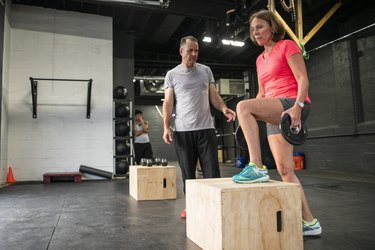

On the one hand, step-ups are easily among the toughest leg exercises out there. On the other, the results are pretty undeniable. Stronger, sculpted thighs and glutes? Yes, please!
Considering this lower-body builder can get pretty challenging, you want to make the most of it. That's where precise form comes in. But there are a few common errors can slow your progress or put you at risk of injury.
Video of the Day
Read on to learn the four most common step-up mistakes — and how to fix them quick.
Related Reading
1. Your Knees Caving In
One of the most common step-up mistakes is letting your top knee collapse inward as you step onto a box or step, says Winnie Yu, DPT, CPT, a New York-based physical therapist at Bespoke Treatments.
Ideally, as you step up, you want to maintain a straight line between your knee and ankle, she says. This helps fire up your quads, glutes and hamstrings, while also keeping your knees in a safe position.
Often, a buckling knee comes down to weakness in the glutes as well as the piriformis, a small stabilizing muscle in the front of your hips. Together, these muscles help keep your knee aligned through the entire exercise, she says.
Fix It
Strengthening your glute muscles is the best thing you can do to fix this mistake over the long term, Yu says. She recommends you add some hip abductor exercises (like lateral band walks) into your regular workout routine.
2. Dropping Back to the Floor
Step-ups are a tough exercise, but you don't want to rush through them. Keep a relatively moderate pace throughout your reps, paying special attention to how you lower, Yu says.
"Exercisers may perform the step-up slow and controlled, but rush through the descent," she says. This mistake hinders a lot of the move's muscle-building benefits. Controlling the lowering (eccentric) portion of your step-ups keeps your muscles working longer, building more strength.
A big reason you may be rushing through the eccentric is weakness in the quads and glutes, she says. Lowering motions demand a lot of control from your muscles. So, if you have a hard time lowering slowly, you may need to do some extra quad and glute exercises.
Fix It
Slow down your descent by counting to two (Mississippis) as you lower with each rep.
If you still have trouble, Yu recommends you check the height of your box. Opt for a lower one to shorten how far you have to lower with each rep. You'll still strengthen your quads and glutes over time.
Then, when your step-ups feel more controlled, you can choose a taller box to keep progressing.
3. Leaning Too Far Forward
Sure, a little forward lean is inevitable (and even good) as you step onto a higher surface. But leaning too far forward can negate some ab benefits, Yu says. You want your body moving in one line, kind of like a moving plank. If your hips stick out behind you, with your chest angling toward the floor, that's a problem.
"This mistake limits full activation of your abdominal and trunk muscles, which should be working throughout the exercise," Yu says.
Fix It
Yu recommends that everyone start step-ups in front of a mirror to check form. You don't want to stare at yourself the entire time, but a glance here and there can help make sure you're not bending forward at your hips. (Don't have a mirror? Record yourself with your phone.)
If you continue to hinge forward at the waist or hips, lower your step and do the exercise without weights (if you aren't already).
4. Pushing Through Your Back Leg
Another common mistake Yu sees is too much reliance on the back leg.
Instead of using their front-leg muscles, many people use their back leg to push off the ground and propel their body up. And while this makes the exercise a lot easier, it also defeats the purpose.
With each rep, your goal is to dial in on the quads and glutes of your lead leg.
Fix It
As you step up, make sure your foot is completely on the box, Yu says. That way, you'll really be able to drive through your front leg and heel.
Working with a shorter step at first is a handy exercise modification that can also help fix this mistake. Higher steps require more quad and glute strength from your front leg.
How to Do a Step-Up With Proper Form
Step-Up
- Stand facing a sturdy step, box or bench with your feet close together.
- Place one foot completely on the step. Brace your core.
- Press through the heel of your front foot to raise your body and stand on top of the box.
- Pause, then slowly lower your trailing foot back to the floor.
- Repeat, doing all reps, then switching legs.
Related Reading